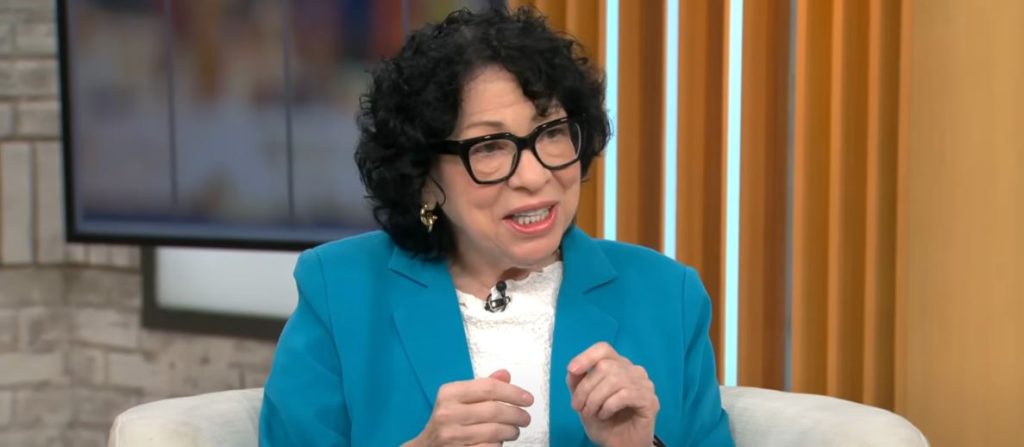
Credit: CBS Mornings
The story of Sonia Sotomayor is remarkably similar to that of innumerable Americans who struggle with chronic illnesses but choose not to let them control their lives. She started receiving daily insulin shots at the age of seven, when most kids were still figuring out elementary school, after receiving a type 1 diabetes diagnosis. She had to mature rapidly after her father passed away from heart issues when she was nine years old, but she embraced discipline, education, and fortitude with a fervor that would eventually catapult her into the country’s highest court.
She became the first Hispanic and only the third woman to serve on the Supreme Court when President Barack Obama appointed her in 2009. However, discussions about her health too frequently overshadow her accomplishments. The liberal base is worried that another vacancy could give conservatives a larger majority, and critics have frequently expressed concerns about whether diabetes could shorten her career. Disability advocates maintain that these fears are incredibly misguided, despite the fact that they are politically understandable. Such demands for her retirement have been referred to as “ableism, pure and simple” by the American Association of People with Disabilities, which emphasizes that her medical condition is well-managed and rarely a disqualifier.
| Category | Details |
|---|---|
| Full Name | Sonia Maria Sotomayor |
| Date of Birth | June 25, 1954 (Age 71) |
| Birthplace | New York City, New York, U.S. |
| Education | B.A. Princeton University (1976), J.D. Yale Law School (1979) |
| Key Roles | Associate Justice, U.S. Supreme Court (2009–present); Judge, U.S. Court of Appeals for the Second Circuit (1998–2009); Judge, U.S. District Court SDNY (1992–1998) |
| Appointed By | President Barack Obama (Supreme Court, 2009) |
| Known For | First Hispanic and third woman to serve on U.S. Supreme Court |
| Health Issues | Diagnosed with Type 1 Diabetes at age 7, treated with insulin |
| Marital Status | Divorced (Kevin Noonan, 1976–1983) |
She demonstrated her ability to manage episodes with remarkable effectiveness in 2018 when paramedics were called to her home for low blood sugar during a health scare. She returned to work that same day. Her candor regarding diabetes has been especially helpful in increasing awareness of a disease that is still poorly understood. She talks openly to law clerks about how she recognizes her symptoms, and she has even used her personal insulin experiences to shed light on more general legal concepts during oral arguments. In addition to making her more relatable, this openness strengthens the remarkably symbolic link between her legal and physical vigilance.
Although the circumstances are very different, the comparisons to Ruth Bader Ginsburg are often made. Ginsburg exemplified a life-threatening illness when she battled cancer for more than ten years before dying in 2020. In contrast, Sotomayor has a condition that can be effectively managed with the use of contemporary insulin technology and close monitoring. According to one disability advocate, it is “a whole different animal” to confuse the two. This distinction is particularly evident: type 1 diabetes is a chronic condition that is frequently treated with advanced pumps, glucose monitors, and medical knowledge rather than a fatal one.
The timing of the conversation is particularly charged. Democrats are afraid they won’t have the opportunity to replace her with a younger liberal justice because elections are coming up and Donald Trump is once again in the political spotlight. The concerns surrounding Ginsburg’s last years were reflected in Senator Richard Blumenthal’s remarks, which urged her to retire early. However, by disregarding decades of evidence that people with type 1 diabetes can run marathons, play in the NFL, or serve on the Supreme Court with distinction, these calls run the risk of framing health as incapacity.
Focus on her actual jurisprudence has been greatly diminished by the political preoccupation with her health. She is known for her strong opinions on voting rights, immigration, and racial equity, which are seen as noticeably better versions of Thurgood Marshall’s support for underrepresented groups. Her voice serves as an anchor for liberal principles in a conservative court, bringing discussions to a moral urgency that many progressives believe is irreplaceable. Her absence would lessen a tone of conscience that she remarkably embodies, in addition to changing the bench’s numbers.
Disability leaders point out that society’s discomfort with chronic illness is evident in the conversation itself. Respected advocate Maria Town emphasized that granting people with disabilities the ability to define their own boundaries is what body autonomy is all about, not just reproductive rights. In Sotomayor’s case, her perseverance has been extraordinarily adaptable, juggling a rigorous public schedule with a condition that necessitates ongoing observation. We should be proud of that balance, not question it.
This narrative is also altered by comparisons to famous people who are dealing with chronic illnesses. NFL players like Jay Cutler managed their athletic careers under similar restrictions, while singer Nick Jonas, who also has type 1 diabetes, continues to tour the world. These instances support the incredibly resilient fact that, with the right tools and discipline, diabetes does not prevent exceptional performance. Sotomayor is a living example of that possibility, having access to top-notch medical care and the discipline of self-discipline.
The narrative has a wider societal impact. Her prominence is both motivating and discouraging to the millions of people who cannot afford insulin. Although she is a prime example of what can be achieved with the right tools, many Americans are still forced to live with the dangerous reality of insulin rationing. As Colorado-based diabetes activist Gail DeVore put it bluntly, “People who can’t afford insulin? They pass away. The success and survival of Sotomayor highlight the injustices that still exist in American healthcare as well as the promise of medical advancement.
More than just her own willpower, her continued service on the bench represents a shared desire for inclusivity. Disability is a different route to greatness rather than a barrier to it. Her voice has, if anything, grown more urgent, and she has been especially creative in incorporating empathy into the otherwise dry fabric of legal precedent. She breaks down stigmas and encourages others to embrace their own vulnerabilities as sources of strength by being transparent about her condition.
While her detractors focus on politics, her supporters see something more significant: a timeless representation of justice, identity, and resiliency. Sotomayor is not defined by her health problems. Rather, they create a story of bravery that is distinctly American—one in which hardship does not prevent one from making history but, astonishingly, fortifies the basis of contribution itself.

